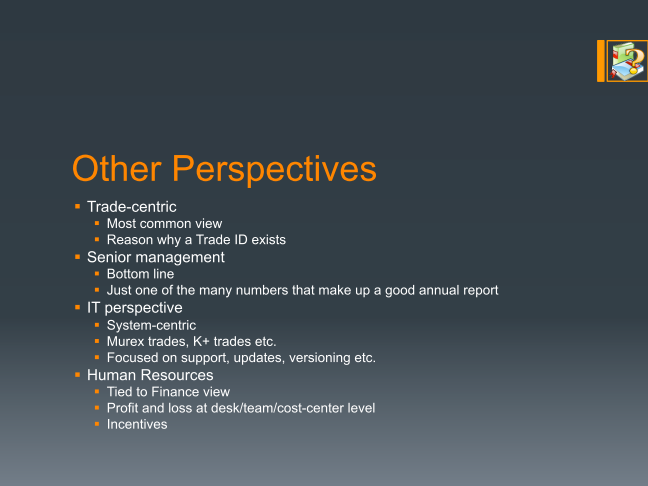In the previous posts, we saw how various teams view the trading activity in their own work paradigm. The perspective that is most common in the bank is still trade-centric. In this view, trades form the primary objects, which is why all conventional trading systems keep track of them. Put bunch of trades together, you get a portfolio. Put a few portfolios together, you have a book. The whole Global Markets is merely a collection of books. This paradigm has worked well and is probably the best compromise between different possible views. The trade-centric perspective, however, is only a compromise. The activities of the trading floor can be viewed from different angles. Each perspective has its role in how the bank works.

From the viewpoint of traders, the trading activity looks asset-class centric. Typically associated with a particular trading desks based on asset classes, their favorite view cuts across models and products. To traders, all products and models are merely tools to make profit.
IT department views the trading world from a completely different perspective. Theirs is a system-centric view, where the same product using the same model appearing in two different systems is basically two completely different beasts. This view is not particularly appreciated by traders, quants or quant developers.
One view that the whole bank appreciates is the view of the senior management, which is narrowly focussed on the bottom line. The big bosses can prioritise things (whether products, asset classes or systems) in terms of the money they bring to the shareholders. Models and trades are typically not visible from their view from the top — unless, of course, rogue traders lose a lot of money on a particular product or by using a particular model.
When the trade reaches the Market Risk Management, there is a subtle change in the perspective from a trade-level view to a portfolio or book level view. Though mathematically trivial (after all, the difference is only a matter of aggregation), this change has implications in the system design. The trading platform has to maintain a robust hierarchical portfolio structure so that various dicing and slicing as required in the later stages of the trade lifecycle can be handled with natural ease.
When it comes to Finance and their notions of cost centers, the trade is pretty much out of the booking system. Still, they manage trading desks and asset classes cost centers. Any trading platform we design has to provide adequate hooks in the system to respond to their specific requirements as well. Closely related to this view is the perspective of Human Resources, who decide incentives based on performance measured in terms of the bottom lines at cost-center or team levels.

